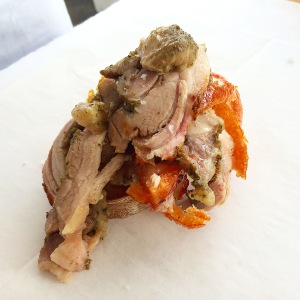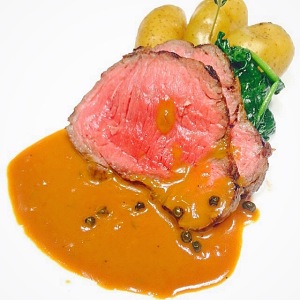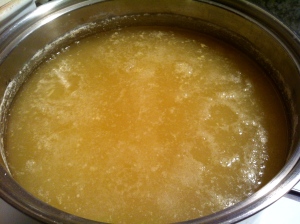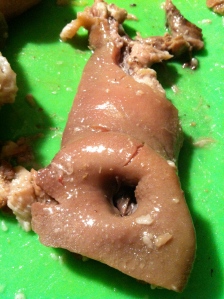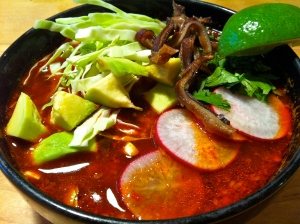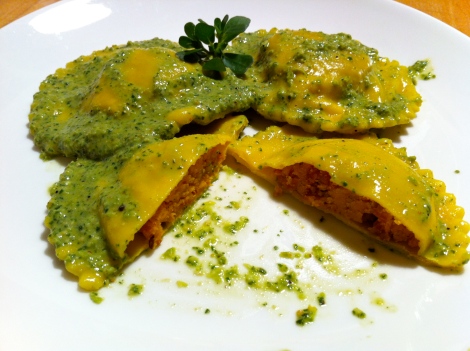Category Archives: Hawai’i
July 8, 2015 Shinsato Farm Rabbit
Local animal protein is starting to become more accessible to home cooks on Oahu. In addition to beef, pork, and chicken, you can now find local venison and rabbit. Ed Kenney started slinging pork and tasty porchetta sandwiches at the Kaka’ako Farmers’ Market a few months back to help Shinsato Farms move product and recently added rabbit to his offerings.
I jumped (or hopped) at the opportunity to play around with some bunny and talked with Ed about his experience working with wabbit at his westaurants. Through Ed’s input, the wonders of google, and my imagination, I managed to use the entire rabbit in three tasty meals.
Rabbit is extremely easy to butcher. It took just a few minutes to divide the skinned, headless carcass into neat, manageable pieces. I first separated the forelegs, then the rear, followed by chopping off the end of the spine and pelvis. Rabbit bones are easy to cut through and my 8” chef’s knife was sufficient. Next, I cut along the spine and separated the loin and saddle, leaving the ribs attached to the loin for aesthetics. I roasted the bones and made stock.
Following Ed’s advice, I made a white ragu with the forelegs. I went with my usual ragu base, but added sprigs of thyme and didn’t include tomato. In a bath of white wine and rabbit stock, I simmered the ragu for about 5 hours, then added fresh tagliatelle and topped with MA’O parsley and pecorino.
I wrapped the saddles in prosciutto, then browned them and the ribs in duck fat and finished to medium in the oven. I sautéed the liver and kidneys, keeping them pink in the center, and served everything over a fig/port puree and covered in jus.
The rabbit’s swansong came in the form of braised legs, another Chef Ed suggestion. I went coq au vin style and rendered lardons in Naked Cow Dairy truffle butter, browned and removed the legs, added and softened the mir poix, then dumped half a bottle of red, rabbit stock, and herbs, returned the rabbit, and braised for a couple hours. I put everything except for the rabbit in the vitamix, then thinned the sauce out with a little more stock. I hit the leg with my Searzall and served it, well-sauced, over Camas Country Mill heirloom polenta. For the polenta, I went 4:1 liquid to cornmeal, using half milk and half rabbit stock, and finished with an ungodly amount of butter and pecorino.
My rabbit adventure was a success. The meat itself was juicy, tender, and tasty. It did not taste like chicken. The 2.5-pound rabbit cost $30 and provided three meals for two people. If you’d like to try for yourself, visit Kaimuki Superette at the Kaka’ako Farmers Market on Saturdays from 8 a.m. to noon.
DISCLOSURE: I paid full price for everything.
- 1 comment
- Posted under Cooking, Hawai'i, Uncategorized
November 7, 2014 Kobe and Cabernet
Jay Theiler from Snake River Farms and Ray Signorello from Signorello Estate recently hosted a couple “Kobe and Cabernet” dinners in Honolulu. Both Snake River Farms and Signorello Estate are family owned operations that focus on quality. Snake River Farms, America’s preeminent Wagyu producer, first entered my radar when I had their buttery soft and delicious beef at Vintage Cave. Signorello meticulously produces small batches of premium wines in Napa. This was some serious beef and wine. My wonderful and talented friend Malia scored an invite, but is busy eating her way through South America, so I was able to go in her stead. The venues for the two dinners were the Plaza Club and the Outrigger Canoe Club; I went with the latter and was treated to a spectacular sunset over the ocean before dinner started.
I sat at Jay and Ray’s table and was pleasantly surprised to see a few familiar faces join us for the meal. The hosts told us about their operations and explained each course and pairing. The party started with Snake River Farms Wagyu filet tartar. An extremely generous portion of very good meat came paired with an interesting full-bodied Signorello Hope’s Cuvée Chardonnay, which is named after Ray’s late mother.
Next was Snake River Farms kurobuta pork belly, the Wagyu of pork, that came with a simple frisée citrus salad and was also paired with the Cuvée.
The belly was followed by my favorite dish of the night, a perfectly cooked and simply seasoned Snake River Farms Wagyu New York steak with green peppercorn demi that was paired with Signorello’s Cab.
The final course was a Snake River Farms Wagyu ribeye wellington that was liberally showered with truffles and served with Signorello Padrone, named after Ray’s late father. Unfortunately, my ribeye was cooked to a tragic medium-well. Fortunately, the silky smooth Padrone was more than enough to make up for it.
Dinner was nothing short of phenomenal. Snake River Farms’ Kobe-style beef is the best you can get short of flying to Japan and Signorello wines are quality even I could taste. If you’d like to try the highest quality steak available on Oahu, try looking for Snake River Farms at BLT Steak, Budnamujip, Michel’s at the Colony Surf, Stage, and Vintage Cave.
Continue reading this article ›
- Leave a comment
- Posted under Hawai'i, Uncategorized
November 12, 2013 The Pig and the Lady
Despite what this blog may lead you to believe, I have a day job. Since getting back to Hawaii in January, I have been working a normal M-F (usually) 8-5ish gig – followed by a 5 a.m. wakeup each Saturday to help with a venture at our most popular farmers’ market. I did the same before this trip and the one before it, and also get to play food with my friends when they pop up – and absolutely love it.
Even if I didn’t have the privilege of being a very small part of something so amazing, today’s long-awaited opening of the brick and mortar would have been a huge deal to me. The story behind the Pig and the Lady could have been taken from a Hollywood script and the food is innovative, brilliant and delicious.
They have received significant recognition and acclaim, most recently #1 in HONOLULU Magazine’s 100 Best Dishes and the Hale Aina Gold Award for Best Vietnamese Restaurant, before having a physical location. Despite all of this, what makes PTL special are the people behind it.
Work hard, play hard has never been better exemplified. The Le family (and their team) work their asses off. I could not continue to function on what little sleep they get, and have been getting for years now. The lack of sleep may contribute to them being hilarious as individuals, and especially together, but it is not the only reason. For all of the early mornings and late nights of grueling work, they are fun, happy, light-hearted, and truly love what they do.
Today’s soft opening of their restaurant was both a celebration and a culmination of all of the above: the story, the food and the people behind both. The restaurant itself, located in walking distance from my day job at 83 N. King St. in Honolulu’s Chinatown, has the best-designed interior I have seen in the state. It feels like you’re walking into a restaurant in San Francisco, Seattle or somewhere else where people value the aesthetics of a restaurant as much as the food itself. The front of the house and kitchen had faces both familiar and new to me, and those that I know are among the best in the industry.
The food was, as always, phenomenal. There were some new dishes and some I had enjoyed before and everything was on point and perfectly executed. The cocktails were on par with the food and the beer list extremely impressive.
A number of friends, family, industry people and lovers of food were at the invite-only event and it was a big lovefest. I’m grateful to have been among those lucky enough to attend and am looking forward to many great meals to come.
September 15, 2013 Hawaii Food & Wine 2013
I had been away during Hawaii Food & Wine for the past couple years and was looking forward to being able to join in on the fun this year. Food & Wine brings some of the top chefs from across the country to Oahu for a week of fun. Due to work, I wasn’t able to fully participate, but it was definitely a week to remember.
Most Saturdays I wake up early and help with The Pig & The Lady at the KCC Farmers’ Market. On the Saturday of Food & Wine, my favorite chef from the Continental US, Chris Cosentino came for breakfast with his family. It was a real treat to serve food I believe in to Offal Chris and they enjoyed their meal.
That night, I attended the “Taste Our Love for the Land” event at the Hawaii Convention Center. There were 19 brilliant chefs cooking up their best and you could revisit their stations as much as you wanted. The huge assortment of wine, craft cocktails, and beer helped wash down each tasty bite.
The chefs took a variety of approaches and it was a treat to see such talented minds going for it! I didn’t get to taste everything, but there were a couple stations I paid a few visits. My top three were: Mark Noguchi’s Kaneohe He`e, Russell Moore’s Grilled goat-king trumpet mushroom kofte kebab, and Ed Kenney’s “Grilled Pa’i’ai and Kukui Nut Broth.”
Gooch’s tako was tender, fresh, and had perfect company courtesy of Ho Farms. Goat was a popular protein and Hawaii’s own Sheldon Simeon laid down a mean kilawen. Russell Moore’s goat kebab was really, really good. In a world of tako, goat, and uni, Town’s Ed Kenney and Dave Caldiero served up a true taste of their love for the land. Pa’i’ai is hand-pounded taro, which was the first staple crop of Hawaii, and I don’t think there is a more signature ingredient in Hawaiian cuisine. The dish was earthy, delicious, and told a story.
As good as the food (and drink) was, the company equalled it; there were chefs, farmers, and food enthusiasts from across the globe and many key players in Hawaii’s food future. It was a well-lubricated, four-hour foodgasm in a beautiful setting with tons of great people.
While I only managed to get a taste of Hawaii Food & Wine, it was one of the best bites I’ve ever had. Hawaii is a great place to be.
- Leave a comment
- Posted under Hawai'i
May 12, 2012 Pig Head Pozole
As Cinqo de Mayo approached there was a lot of talk about pozole. I couldn’t recall hearing about the pre-Columbian Mexican soup prior to this year and it captured my interest. There are several different versions of pozole, but the most intriguing was pozole rojo, made with hominy, chillies and, usually, pork. I didn’t make it to the Honolulu’s Cinqo de Mayo celebration to try Zaratez‘ take on pozole, but hit up Serg’s, a place near my house that makes some really good tacos. For Cindqo de Mayo they offered a pozole verde, which was greasy, salty, and a huge disappointment. It became clear to me that I would have to take matters into my own hands.
Mercado De La Raza is the only Mexican grocery that I know of on island and was naturally my first stop for ingredients. I picked up dried chilies, some really funky purple corn, and cal (calcium hydroxide). The total was only $4! I went to my usual purveyor of pig in Chinatown and picked up half of a head. The butcher lady was a little put off by my wanting an half of a head instead of my usual jowl. Her confusion and the language barrier led to me getting a boneless half head, but it didn’t end up affecting the outcome.
Pig Head Pozole:
pig head (1/2 head) *shave or burn off any hair
hominy (made from 1 lbs dried corn and cal)
dried chilies (4 hot, 4 medium)
onion (1)
garlic (8 cloves)
carrot (1)
celery (1 stalk)
pork stock (2 cups homemade frozen concentrate)
water
cumin
chili powder
salt
pepper
Garnish:
crispy pig ear
cilantro
radish
cabbage
avocado
lime
The party started with sautéing 1/2 of the onion in a big, heavy pot, then throwing in the carrot, celery, and a few cloves of garlic before adding the head, pork stock, and water. I added cumin, salt, and pepper, brought everything to a boil and let it simmer for about 5 hours, periodically skimming the surface.

Once everything was under control with the soup, I moved on to the hominy.
I filled another big, heavy pot with water, added the corn and the cal, and brought it to a boil. I let it simmer for about 3 hours, then shut off the heat and left it on the stove overnight.
After about 5 hours, I removed the soup from the heat, strained the liquid, pulled apart the head meat, then refrigerated both overnight.
The next day, I skimmed off the fat from the surface of the now congealed broth (which was surprisingly very little) and brought it back to a boil. Next, I chopped the gelatinous chunk of meat into manageable pieces and added them to the broth. I drained the corn and rinsed it several times to be sure to remove all traces of the cal, then added it to the soup.

Prior to cooking the head, I removed the ear and set it aside. At this time, I put the ear in a small pan with water and brought it to a boil. I dumped out the scummy water, replaced it with fresh water and returned the ear to a boil. I added cumin, chili powder, salt and pepper, then simmered the ear for about 2.5 hours. While this was going on, I toasted my chilies, then sauteed the other half onion and garlic in the fat I scraped off from the top of the broth. I removed the ear from the pan and used the liquid to rehydrate the chilies, which took about 30 minutes. I put the chillies, onion, and garlic into the food processor with a little of the rehydrating liquid and pulsed it into a paste.

I added the chili paste to the soup and let it simmer for a few hours. That was pretty much it for the soup. I cut the ear into thin strips, sprinkled them with sea salt and put them under the broiler. For garnish I went with the ear, avocado, radish, cabbage, cilantro, and lime.
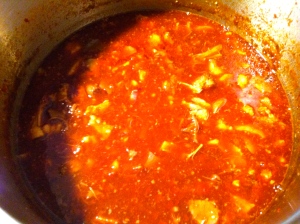
The slices of ear lost their crispiness once they met the broth and will not be including in future pozole endeavors. I also forget Mexican oregano when I was at the market and will be including it next time around. The broth was really good, full of porky richness and a nice amount of heat. The meat was tender, pieces of skin like butter, and the hominy very bean-like. There are relatively few ingredients involved and the only solids in the soup itself are pork and hominy. The garnishes provided interesting textures and, with the exception of the not-so-crispy crispy pig ear, everything in the bowl got along swimmingly. I’m my own harshest critic and was very pleased with the outcome. I have a new favorite soup!
- 4 comments
- Posted under Cooking, Hawai'i
January 16, 2012 Hawaiian Red Veal Tongue with MA’O Baby Root Vegetables

Last Saturday at the KCC farmers market, my friend Nanette let me know that Hawaiian Red Veal had brought some offal to sell, including two tongues. I’ve eaten tongue, but this would be my first time cooking it. MA’O Organic Farms had some baby root vegetables that looked like the perfect companion for the tongue.
Pinot Braised Hawaiian Red Veal Tongue:
Hawaiian Red Veal tongue (about 1.25 lbs)
guanciale (2 1/4″ slices from my home cured guanciale, cut into 1/4″ strips)
butter (2T for the guanciale, 1T for roux, 1T for mushrooms)
shallots (4, quartered, from Pit Farm)
carrots (1 purple, 1 yellow, from Pit Farm)
celery (1 stalk, from Pit Farm)
roma tomatoes (3, skinned and cored, from Ho Farms)
garlic (2 cloves, smashed)
thyme (3 sprigs)
bay leaves (2 from tree at my house)
wine (about 3 cups of pinot noir)
chicken stock (1-2 cups, homemade)
Hawaiian sea salt
black pepper
parsley (from my garden for garnish)
Small Kine Farm baby portabella mushrooms (handfull, halving the bigger ones)
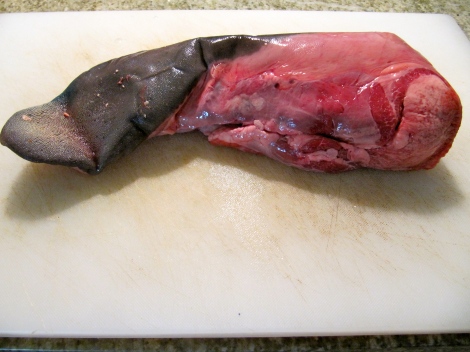
Once in the kitchen, the first thing I had to do was remove the skin from the tongue. I simmered the tongue in water for 1 hour

then removed the skin with a knife.
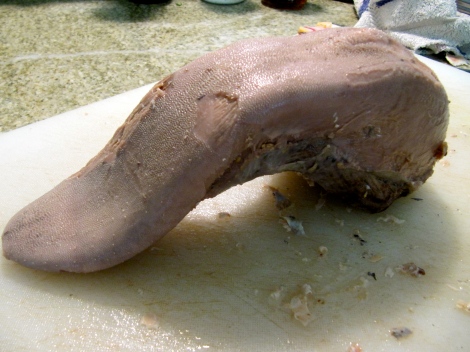
Next, I rendered the fat out of the guanciale in butter, then removed the guanciale.

I browned the lightly floured tongue in the guanciale fat/butter and set it aside. Next, I added shallot, carrot, and celery to the pan. When they were about ready, I added the garlic, then the tomato. I returned the tongue and the guanciale to the pan, then added the wine, chicken stock, thyme, and bay leaves and seasoned with salt and pepper.
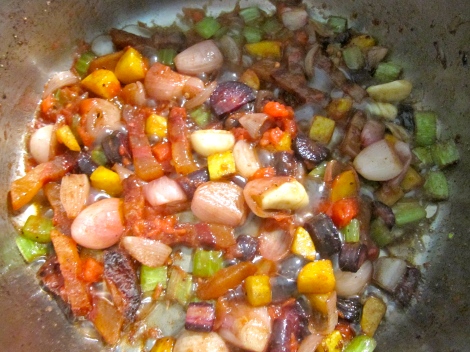
I let everything simmer on low heat for 4 hours, turning the tongue a couple times and making sure there was enough liquid in the pan. I removed the tongue and strained the braising liquid. I returned the liquid to a pan and added some roux to thicken it into a sauce. I sauteed some Small Kine Farm baby portabella mushrooms in butter, then added them to the sauce. I put the tongue in with the sauce and mushrooms and warmed it back up. For service, all I had to do was remove the tongue, slice it, plate it, top it with the sauce, and serve with the root vegetables.
Roasted MA’O baby root vegetables:
1 pound baby turnips, radishes, beets, carrots
thyme (3 sprigs)
rosemary (1 sprig)
Hawaiian sea salt
black pepper
extra virgin olive oil
I went with a simple roast for the root vegetables. I scrubbed them in the sink, removed the tops and bottoms, and tossed them in the olive oil, salt, pepper, thyme, and rosemary. They were ready to party after about 30 minutes in a 400 degree oven.
I was extremely satisfied with how the meal turned out. A knife was not required for the tongue, the sauce was very rich and flavorful, and the vegetables were crisp and delicious.
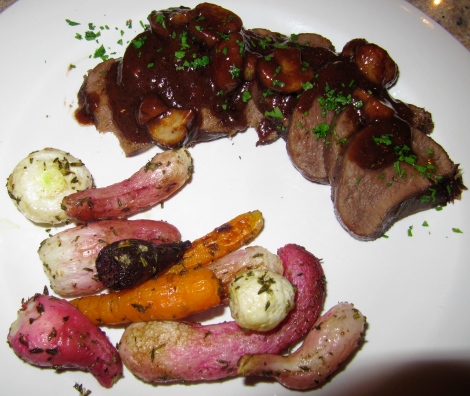
- Leave a comment
- Posted under Cooking, Hawai'i
January 3, 2012 Rib Eye Ragu
I enjoy pasta…a lot… I typically make pasta a couple times a week and usually sauce it with some sort of ragu. Hawai’i has come a long way in the past few years and I’m able to source most of the vegetables I use locally. Meat is another story. There is not a single butcher shop on Oahu. Finding local meat is no easy task. Unfortunately, I buy the majority of my meat from Safeway; more specifically, from the small section of soon to expire meat that is discounted 30-50 percent at the Manoa Safeway. I buy whatever is looking the best and the best value. Today there were some nice looking bone-in rib eyes and I took one home with me to make a ragu.
Rib Eye Ragu:
rib eye steak (1.25lbs, bone-in)
roma tomatoes (16 small/medium from Ho Farms)
onion (small from Pit Farm)
carrot (1 purple, 1 yellow from Pit Farm)
celery (1 stalk from Pit Farm)
garlic (2-3 cloves)
chili (2 Hawaiian chilis from pit Farm)
fresh herbs (minced rosemary, sage, basil, parsley and a bay leaf from garden)
wine (1/2 cup or so, i used prosecco that had gone flat)
olive oil
salt and pepper to taste
Cut the steak into chunks and brown them and the bone in olive oil. I like to get everything nice and brown. While browning the beef, I took care of the tomatoes. I cut a small x onto the bottom of each tomato, emerse them in boiling water until the skin begins to peel, then submerge them in an ice bath. Next, I remove the skin, seeds, and base of stem, then chop them up finely. Once the beef is browned to your liking, add the onions, carrot, and celery. I chop my mirepoix very finely, how you do it is up to you. Once the mirepoix is soft and looking ready, I add the garlic. The garlic cooks fast and I drop the herbs in just before the garlic is done. Once everything is ready, I deglaze the pan with wine, then add the tomatoes. I like heat and drop a couple chilis in to give the ragu a kick. This concludes the active cooking part of the sauce. All you have to do now is reduce the heat to low, stir occasionally, and add water if things get too dry. I usually simmer my sauces for 4+ hours, but was in a bit of a rush today and was only able to simmer for a little over 2 hours. It was long enough for the meat to become fork tender and that’s all you really need. I removed the bone, the chilies, and the bay leaf, pulled apart the steak, and made sure the ragu was properly seasoned. Since I made ravioli the day before, I went with quick and easy hand cut pasta to go with the ragu.
Pasta
00 flour (about 3 cups)
eggs (3 local eggs)
olive oil (splash)
water (splash)
salt (pinch)
I put 1 cup of flour, the eggs, salt, and the olive oil into my kitchenaid stand mixer and blend well, then add the rest of the flour. Add flour or water until proper consistency is achieved. The dough should no longer be sticky, but not be dry enough to fall into a bunch of little pieces. Once the dough is looking good, I let the mixer do its magic for 10 minutes, then wrap the dough in plastic, and allow it to rest for at least 30 minutes. I run the dough through my manual pasta machine and stop at number 6 or 7 depending on which type of pasta I’m making. My machine starts at 0 and the highest number (thinnest pasta) is 9. Since I was going with a rich, heavy sauce, I went for a thicker pasta to absorb the goodness. Once the pasta is rolled to the desired thickness, I flour both sides, fold it over itself a couple times, and cut it with a knife. I usually do strips a little under a half inch wide. My personal preference is for wider, thicker noodles. After the noodles are cut, I unfold them and toss them on a floured surface. It only takes a few minutes for the pasta to cook. Once the pasta was cooked, I tossed it with the ragu, and topped with freshly grated pecorino.
The outcome: I make a lot of ragus and a lot of pasta, so I’ve had plenty of practice. The practice pays off and I had another delicious meal. The rib eye ragu really tasted like rib eye and was quite good. The pasta was its normal, wonderful self.
- Leave a comment
- Posted under Cooking, Hawai'i
January 2, 2012 Sausage and Kabocha Ravioli in Purslane Pesto
It looks like I won’t be doing any traveling until my financial situation drastically improves. In the meantime this blog will be based on things I do at home in Hawaii. One of those things is cooking and I’m going to start sharing what I make and how I make it. I apologize for the lack of pictures and will try to start taking some action shots in the future.
Last Saturday I picked up 1/2 a kabocha pumpkin from my favorite vendor at the farmers market, Pit Farm. I’ve made kabocha ravioli in the past and decided to do something other than tossing it in a brown butter sage sauce this time. One of my pantry items at home is Kukui Italian Sausage. While I would prefer to make my own, Kukui is locally made and good enough for me. I use it a lot for all kinds of different stuff and it’s handy to have on hand. I thought that adding sausage to the filling would compliment the pumpkin well.
While at the farmers market, I also picked up some purslane from Otsuji Farm, without knowing what I would do with it. My only encounters with purslane have come in salad form and I decided to see how it would work in a pesto. When I went to Whole Foods to pick up pine nuts, they were sampling a deliciously creamy goat cheese, le picandou, that found its way into the pesto. Meyer lemons are currently going off on Oahu and my roommate obtained a big bag of them from a friend’s tree.
Needless to say, I got my hands on some pretty great ingredients. My only goal was not to mess them up!
Ravioli dough:
00 Flour (around 3 cups)
3 Eggs (local of course)
Kabocha (about 1/2 cup roasted and mashed)
salt (pinch)
extra virgin olive oil (little splash)
For the dough, I mix everything in my Kitchenaid stand mixer. I add more flour or olive oil depending on the consistency of the dough until it is no longer sticky, but not quite falling apart into a bunch of small pieces. Once the desired consistency is reached, I let the machine work the dough for about 10 minutes, wrap the dough in plastic and let it rest for about an hour. I incorporated a little kabocha to get some extra pumpkin-ness and brighten the color of the pasta.
Ravioli filling:
Kabocha (1/2 of a kabocha, but didn’t use all)
Sausage (8oz Kukui Italian Sausage)
Sage (a dozen or so leaves from my garden, finely chopped)
Nutmeg
Salt and pepper to taste
I covered the squash in olive oil, sprinkled some salt and pepper, and grated fresh nutmeg, then roasted for about 40 minutes at 325. I removed the casings from the sausages and, since they are pre-cooked, diced them up before browning. I browned the sausage in olive oil and added the sage just before they were done. I combined the squash and sausage/sage mixture in a food processor with a little more freshly grated nutmeg and the filling was ready.
Pesto:
Purslane (a few cups maybe? washed and thick stems removed)
Meyer Lemon (juice and zest of 1/2 a lemon)
Goat Cheese (a couple ounces of le picandou)
Pine Nuts (1/3 of a cup-ish, toasted)
Garlic (2-3 cloves)
Extra Virgin Olive Oil
Salt and Pepper to taste
Pesto is really easy. I drop the first 5 ingredients into the food processor, then gradually add olive oil until it reaches my desired consistency.
The outcome: It came out really well. The flavors were great and complimented one another nicely. My dining companion has lactose issues, so I took it easy on her and didn’t add any cheese to the filling. As a result, the ravioli filling was a little dry. If I make it again, I will put some of the goat cheese in the filling. The meyer lemon was REALLY juicy and I could have used a little less juice than I did. It was a little tart, but nothing overboard and it lightened up the pesto in a nice way. Overall, I was very happy with the dish and would make it again.
- 2 comments
- Posted under Cooking, Hawai'i
December 10, 2011 Naked Cow Dairy
I recently had the opportunity to take part in a cheese making workshop with my local Slow Food chapter at Naked Cow Dairy in Waianae on Oahu’s leeward side. Two sisters, Monique and Sabrina, own and operate Oahu’s only dairy, where they produce buttermilk, yogurt, butter, and cheese. The only cheese the ladies have been taking to market has been (cow milk) feta. This workshop was meant to test a variety of other cheeses and see how they fare with Naked Cow’s milk and our climate. We made camembert style, gouda style, ricotta, crescenza, and yogurt cheese.
I had never made cheese before and jumped at the opportunity to take part in the workshop. Making the cheese itself was a lot of fun, but involved quite a bit of waiting. The ricotta and yogurt cheese were ready for immediate consumption and came out very well. We are a couple months away from sampling the gouda and camembert style and I’m really looking forward to tasting the fruits of our labor. For now, the cheese is being aged in a modified wine fridge, but the ladies are working on making a commercial scale aging chamber in the near future. Producing added value products like cheese, will help Naked Cow become profitable and grow.
We had a delicious lunch that included great local produce as well as some treats that our Slow Food leader, Gida brought back from France. The dairy is set in a beautiful part of the island and we were there for another spectacular Hawaiian sunset. I could not have asked for a nicer location, more welcoming hosts, better company, or a more perfect first experience cheesing it up. Naked Cow is now taking part in agritourism and it is definitely worth a visit to come and experience Oahu’s only dairy.
- Leave a comment
- Posted under Hawai'i
April 22, 2011 Slow Food KCC Maui Trip
I had been a very inactive member of my university system’s Slow Food Chapter, Slow Food KCC (Kapiolani Community College), but things changed when I received an email about a Maui trip. Maui is my favorite island in the Hawaiian archipelago and there was no way I could pass on a club subsidized ag-tour. Our wonderful president, Gida and culinary student/amazing person Wendy did all of the work setting up this great trip. Thanks ladies! Wendy has an auntie with a beautiful house/protea farm in Kula that she was kind enough to let us stay at for the weekend.
We arrived in Lehue at about 9 am and our first stop was Roselani Tropics Ice Cream. It’s a family owned and operated ice cream maker/Coca Cola bottler and we received a tour and got to sample some of the product. Sweets aren’t really my thing and I don’t touch soda unless there’s booze in it, but it’s always good to see a local business hanging in there.
Our next stop was Ulupalakua Ranch, a part of Maui Cattle Company. The story of the ranch was as beautiful as the views. Ranching has a long history in Kula and the current owners of Ulupalakua have written one of the best chapters. Thousands of acres have been protected from development, native plants have been reintroduced, electric prods and whips are not used, rotational grazing was implemented, and alternative energy is used to power the facility. There is also a winery on the premises, which we got to tour and sample. This was the first time in my life that I couldn’t finish pours at a tasting. The stuff was horrible. We had lunch at the restaurant and, unlike the wine, it was very good.
From the ranch, we proceeded on to Shim Farm. Casey Shim looks like he is about 106 years old and does all of the work on the farm himself. He is a retired school principal, Army officer, and a really happy guy. He refers to his home/farm as “utopia” and I believe him. He produces coffee and flowers, has 2 horses and grows a variety of fruits. I really enjoyed our short time at his little farm and didn’t want to leave.
For dinner, we returned to Wendy’s aunt’s house and cooked together. Being the only non-pro/pro-in-training, I relegated myself to salad duty and let the experts do their thing. Dinner was delicious. The steak prepared by our special guest, chef at the Honolulu Convention Center and great guy, Jacob Silver was a real treat.
The next morning we went to the Maui Community College Swap Meet/Farmers’ Market. It was geared primarily towards tourists and a lot of the “farmers” were selling produce that came from the continent.
Next, we went to Maui’s hippy enclave, Paia and had pizza for lunch at Maui Flatbread Company. I had eaten there on a previous trip to Maui and, once again, it was good. We had a brief stop at the fledgling Maui Olive Company. A family has taken advantage of upcountry’s unique climate and started an olive orchard. The trees are only one year old and will not produce fruit suitable for making oil for another 2 years, but it looks very promising.
Our next stop was another one of Wendy’s auntie’s houses, Upcountry Farm Specialties. Wendy’s auntie and her husband, a retired Swiss chef, own and operate UFS. They were a very intelligent, happy, and welcoming couple. It was evident that there was a woman’s touch here. Casey Shim’s utopia seemed like the creation of lone man with ADD compared to this well organized, meticulously maintained operation. Don’t get me wrong, I liked both very much, but they were different. UFS grows coffee, christmas trees and a variety of exotic fruits and vegetables. The unique microclimate of upcountry Maui enables them to grow nearly everything imaginable. There was a peach tree growing next to a pineapple plant and, during the winter, they can actually grow brussels sprouts in Hawai’i!
After we tasted a variety of jams and spreads at UFS, we went to Surfing Goat Dairy. Surfing Goat seemed very commercial after our previous trips to small operations, but was still enjoyable. We got to tour the facilities, milk goats, and sample cheese.
We went ‘home’ and caught a beautiful sunset before the hour long drive to Star Noodle for our splurge meal of the trip. Star Noodle is the hottest new restaurant on the garden isle and we were all looking forward to it. The chef has weekends off and wasn’t there for our meal. I’m hoping this is the reason why things were not cooked properly and that our experience was an exception. The menu comes from all over Asia and looks extremely promising. The problem with our meal is that things simply weren’t cooked properly and that is what matters in the end. The service was great and we got to tour the kitchen, but the meal itself was a disappointment.
Wendy’s Auntie’s house is located just 30 minutes from Hale’akala, and I couldn’t be that close and not watch the sunrise. Only one of my traveling companions was willing to wake up at 4 am to make it to the summit in time for the birth of a new day. Charles and I went up and witnessed a beautiful sunrise, then enjoyed the scenic drive back to the house. It was Easter Sunday and everyone worked together to produce a delicious easter brunch.
After brunch we went to Alii Kula Lavender and got to walk around their lavender farms. It wasn’t really my thing, but the grounds were pretty. From there, we went to Haiku Maui Orchids to check out a self sustaining tilapia pond and orchard farm. Flowers aren’t really my thing, but there were some pretty cool/exotic ones.
The ‘happy ending’ to our trip was Maui Brewing Company. Our gracious host came to give us a tour/tasting on Easter Sunday and it was really enjoyable. As much as I love Kona Brewing Company, MBC is the REAL local brewery in Hawai’i. I was fortunate enough to sit next to a non-drinker for the sampling portion and managed to get a very solid buzz on. We went to MBC’s nearby restaurant for our last supper and had more delicious beer with a good meal.
This was an amazing three days and, by the end of the trip, all of us were seriously considered moving to Kula. Each place we visited offers similar tours and I highly recommend checking at least some of them out when in Maui.
- Leave a comment
- Posted under Hawai'i
